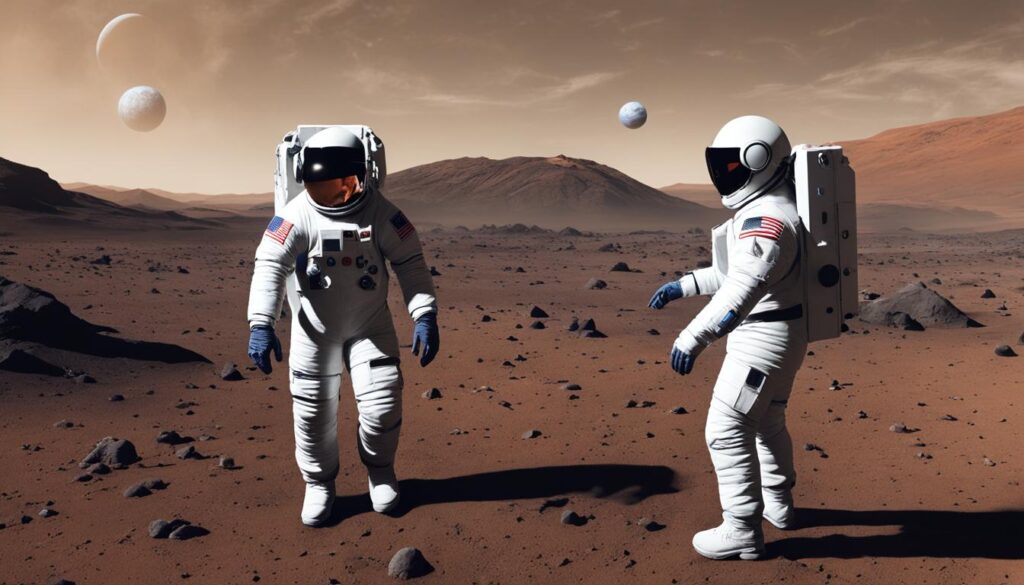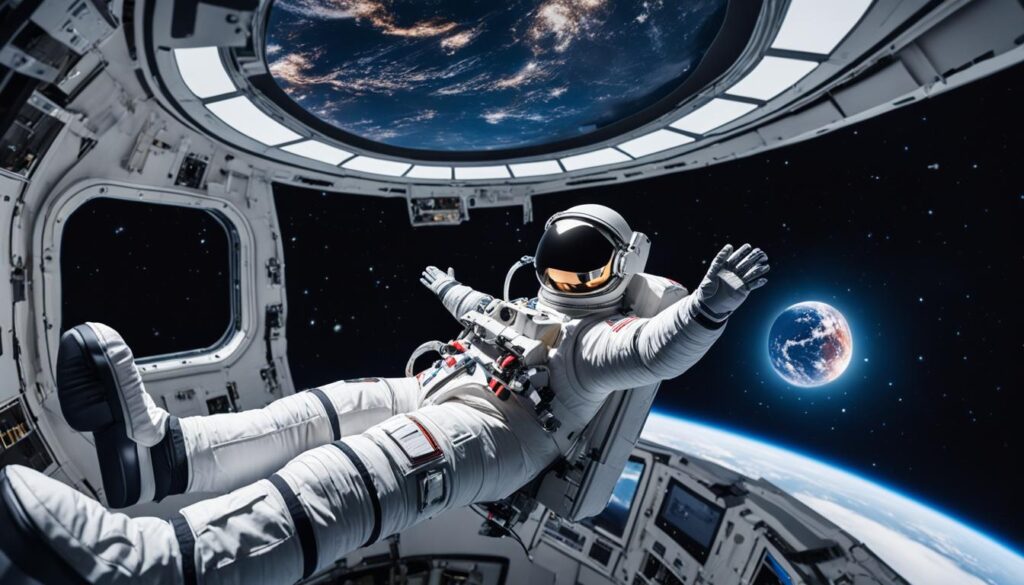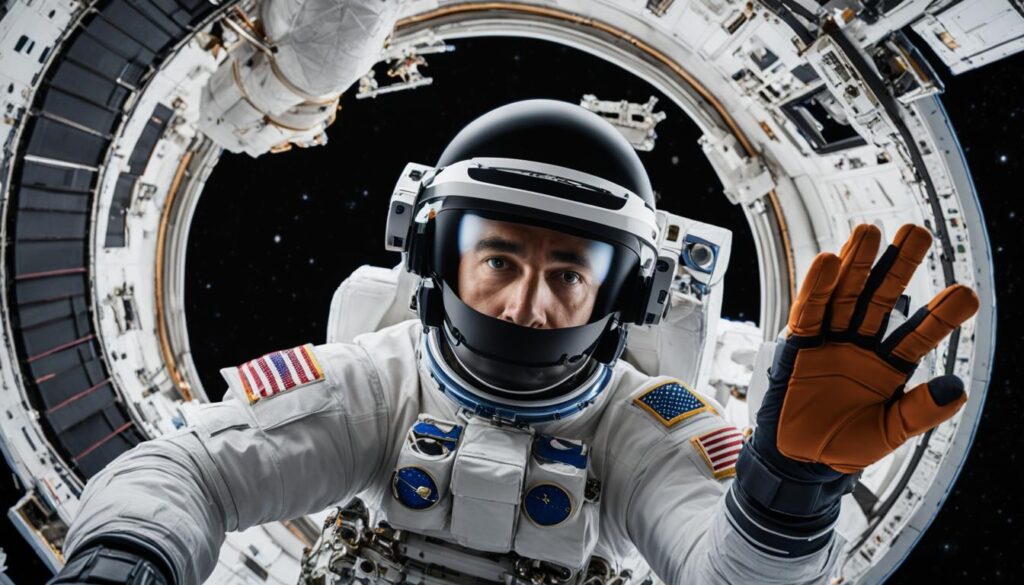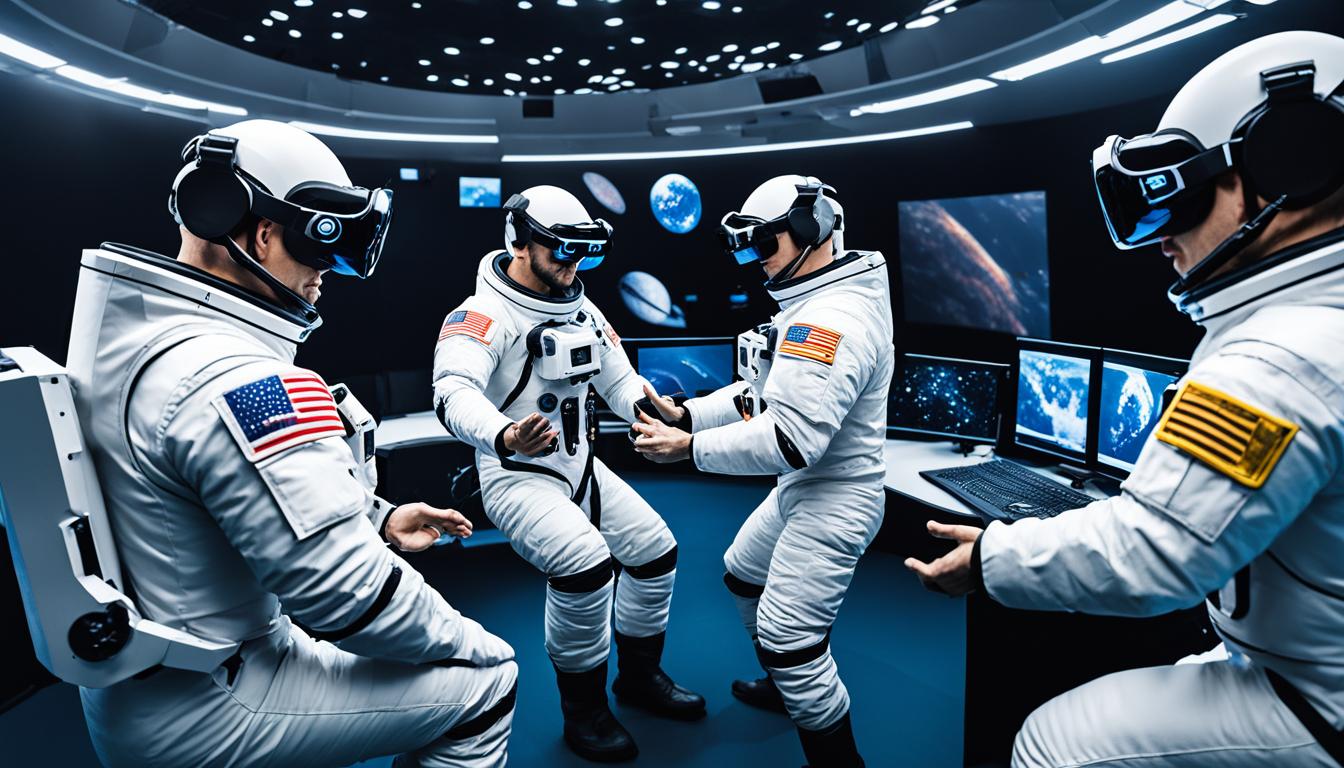Welcome to an exciting era of astronaut training! NASA is leading the way in revolutionizing the training methods for our future space explorers. By harnessing the power of virtual reality (VR) and augmented reality (AR) technology, NASA is providing astronauts with immersive and hands-on training experiences that prepare them for the challenges of space.
Through virtual reality training, astronauts can simulate complex tasks in a controlled environment, preparing them for the unique conditions they will encounter in space. These simulations provide a realistic and interactive learning environment that helps astronauts develop critical thinking and problem-solving skills.
Augmented reality, on the other hand, enhances the training process by overlaying holograms and diagrams onto the physical surroundings of the astronauts. This technology allows crew members to receive hands-free assistance and guidance, improving the efficiency and safety of their training.
NASA’s innovative use of VR and AR in astronaut training aims to reduce crew training requirements, increase efficiency, and improve safety during space missions. By incorporating these immersive technologies, NASA is pushing the boundaries of what is possible and preparing astronauts for the future of space exploration.
Contents
- 1 The Benefits of Virtual and Augmented Reality in Astronaut Training
- 2 NASA’s Use of Virtual and Augmented Reality Tools
- 3 AR Maintenance Assists and Upgrades
- 4 The ISS Experience: Immersive VR Series
- 5 Enhancing Astronauts’ Grip and Manipulation Abilities
- 6 Conclusion
- 7 FAQ
- 7.1 How is NASA incorporating virtual reality (VR) and augmented reality (AR) technology in astronaut training?
- 7.2 What are the benefits of virtual and augmented reality in astronaut training?
- 7.3 What virtual and augmented reality tools has NASA developed for astronaut training?
- 7.4 How is augmented reality used for maintenance and upgrades in space?
- 7.5 How does NASA use virtual reality for studying time perception in microgravity?
- 7.6 What is The ISS Experience?
- 7.7 What is the GRIP investigation?
- 7.8 How has NASA’s use of virtual and augmented reality in astronaut training revolutionized the training process?
- 8 Source Links
Key Takeaways:
- NASA is using virtual reality (VR) and augmented reality (AR) technology to train astronauts for space missions.
- Virtual reality training allows astronauts to simulate complex tasks in a controlled environment, enhancing their critical thinking and problem-solving skills.
- Augmented reality provides hands-free assistance and guidance, improving the efficiency and safety of astronaut training.
- NASA aims to reduce crew training requirements, increase efficiency, and improve safety through the use of VR and AR in astronaut training.
- VR and AR technologies are revolutionizing the way astronauts are prepared for the challenges of space exploration.
The Benefits of Virtual and Augmented Reality in Astronaut Training
Virtual and augmented reality technologies have brought significant benefits to the training of astronauts, enhancing their preparation for space missions. Through virtual reality simulations, astronauts can engage in realistic and immersive training experiences, allowing them to practice complex tasks within controlled environments.
These VR simulations play a crucial role in replicating the challenges and conditions faced in space, enabling astronauts to develop critical thinking, problem-solving skills, and muscle memory necessary for successful missions. By providing a safe and controlled platform for training, virtual reality simulations significantly reduce risks associated with real-time training exercises.
Astronauts can use virtual reality to simulate extra-vehicular activities (EVAs), spacecraft operations, and even emergency scenarios. This training equips astronauts with the necessary knowledge and skills to handle high-pressure situations, enhancing their readiness and adaptability for any challenges they may encounter during space missions.
In addition to virtual reality, augmented reality applications have transformed astronaut training by providing hands-free assistance and guidance during tasks. Through the augmented reality overlay, crew members can access live holograms and diagrams that enhance their perception of the physical environment.
Augmented reality allows astronauts to interact with these virtual elements while still maintaining awareness of their surroundings. This technology improves efficiency and reduces the time spent on training, as astronauts can quickly access crucial information and instructions without the need to refer to manuals or external resources.
“Virtual and augmented reality technologies have revolutionized astronaut training by providing realistic simulations and hands-free assistance, enabling astronauts to develop critical skills and enhancing their efficiency during space missions.”
The benefits of virtual and augmented reality in astronaut training can be summarized as follows:
| Benefits of VR in Astronaut Training | Benefits of AR in Astronaut Training |
|---|---|
|
|
The combination of virtual and augmented reality technologies has revolutionized astronaut training, providing astronauts with realistic simulations, hands-free assistance, and improved efficiency during space missions.
NASA’s Use of Virtual and Augmented Reality Tools
When it comes to preparing astronauts for the challenges of space, NASA has harnessed the power of virtual and augmented reality. These cutting-edge technologies have been specifically developed to enhance astronaut training and provide valuable hands-on experiences. Through the use of virtual reality tools and augmented reality training programs, NASA is revolutionizing the way astronauts are prepared for their missions.
“Virtual and augmented reality technologies have provided astronauts with unprecedented training opportunities, allowing them to practice and perfect their skills in a simulated space environment,” says Dr. Sarah Collins, a leading researcher at NASA’s Astronaut Training Division.
One of the virtual reality tools utilized by NASA is the Sidekick goggles. These high-tech goggles provide astronauts with hands-free assistance by displaying 3D schematics and diagrams of physical objects. By overlaying virtual information onto the real world, Sidekick enhances crew members’ understanding of complex equipment and procedures.
The use of virtual reality technology extends beyond equipment visualization. NASA is also testing virtual reality control of robots, enabling astronauts to remotely operate robotic arms and space vehicles using intuitive VR interfaces. This advancement allows astronauts to perform delicate maneuvers and conduct intricate tasks from a safe distance, while still ensuring precision and accuracy.
Another notable application of virtual reality in astronaut training is the Immersive Exercise program. This VR environment motivates astronauts to exercise by providing an immersive and engaging workout experience. By simulating different environments and exercises, the Immersive Exercise program helps astronauts stay physically fit during their time in space.

The Benefits of NASA’s Virtual and Augmented Reality Tools
The adoption of virtual and augmented reality tools by NASA has brought numerous benefits to astronaut training programs. By immersing astronauts in realistic simulations, these technologies allow for safer and more efficient training experiences. Astronauts can practice complex tasks and procedures in a controlled environment, enabling them to develop critical thinking and problem-solving skills that are crucial for success during space missions.
A key advantage of virtual reality technology is its ability to provide an accurate representation of the harsh conditions and unique challenges astronauts may encounter in space. By replicating zero gravity environments, extreme temperatures, and the vastness of space, virtual reality simulations prepare astronauts for the realities of their missions.
Augmented reality training programs offer a different set of benefits. By overlaying holograms and diagrams onto their physical surroundings, augmented reality provides hands-free assistance to astronauts during complex procedures. This technology enhances efficiency and reduces the time spent on training, ultimately improving the overall effectiveness of astronaut preparation.
Future Applications of Virtual and Augmented Reality in Astronaut Training
The use of virtual and augmented reality in astronaut training continues to evolve, with NASA exploring new applications and advancements. One area of focus is the development of adaptive training programs that tailor the training experience to individual astronauts’ needs and skill levels.
| Application | Description |
|---|---|
| Virtual Reality Simulations | Realistic simulations that allow astronauts to practice complex tasks and develop critical thinking skills. |
| Augmented Reality Maintenance Assists | Hands-free assistance during equipment inspection and maintenance, improving efficiency and reducing training time. |
| Time Perception Studies | Investigating the effects of microgravity on astronauts’ perception of time and cognitive abilities using virtual reality. |
| Immersive VR Experiences | Virtual reality series providing viewers with an immersive perspective of life aboard the International Space Station. |
As technology continues to advance, virtual and augmented reality will play an increasingly vital role in astronaut training. These tools have the potential to revolutionize not only how astronauts prepare for space missions but also how they perform tasks in space. With ongoing research and development, NASA remains at the forefront of utilizing virtual and augmented reality to shape the future of space exploration.
AR Maintenance Assists and Upgrades
NASA is harnessing the power of augmented reality (AR) to revolutionize spacecraft maintenance and repair activities. By incorporating AR, NASA aims to provide crew members with real-time guidance and assistance, reducing training time and improving efficiency in equipment inspection and maintenance tasks.
One example of NASA’s use of AR technology is the T2 AR system, which assists astronauts in inspecting and maintaining the T2 Treadmill. This AR application runs on tablets or headsets, interpreting the camera feed to provide step-by-step instructions and highlight potential issues. By leveraging AR technology, astronauts can quickly identify and address maintenance needs, ensuring the smooth operation of crucial equipment.

This captivating study opens the door to a deeper understanding of the human mind’s relationship with time and how it is influenced by the unique environment of space. The findings may also have broader applications, contributing to our understanding of human perception and cognition in various contexts on Earth.
As the exploration of space continues, studies like the Time Perception study play a vital role in enhancing our understanding of the human experience in microgravity and ensuring the success of future space missions.
The ISS Experience: Immersive VR Series
Experience life aboard the International Space Station like never before with The ISS Experience, a groundbreaking virtual reality series that takes viewers on an unforgettable journey to low-Earth orbit. Through the use of cutting-edge 360 cameras specifically designed for space, this immersive series provides a unique perspective of the challenges, triumphs, and everyday life of astronauts onboard the ISS.
Step into the shoes of an astronaut and witness first-hand the awe-inspiring beauty of Earth from space. Feel the weightlessness as you float through the cramped modules of the space station. Witness breathtaking spacewalks and the delicate maneuvers required to dock spacecraft. This virtual reality series brings you closer to the action than ever before, allowing you to experience the sights, sounds, and even the emotions of life in space.
By documenting the real-life experiences of astronauts living and working in space, The ISS Experience aims to inspire future research and exploration. Through this immersive virtual reality journey, viewers gain a deeper understanding of the challenges faced by astronauts and the vital work they undertake to advance our understanding of space.
“The ISS Experience transports you to the forefront of human space exploration, providing a captivating and educational journey that showcases the dedication and ingenuity of the crew onboard the ISS.” – Astronaut Jessica Meir
As we look to the future of space exploration, The ISS Experience offers valuable insights that can help improve conditions for astronauts on long-duration missions and pave the way for further space exploration endeavors. By capturing the essence of life aboard the ISS, this virtual reality series fosters a sense of wonder and curiosity about the vastness of space.
Key Highlights of The ISS Experience:
- Realistic portrayal of life in space using state-of-the-art 360 cameras
- Immersive virtual reality experience that engages all your senses
- Incredible spacewalks and spacecraft maneuvers
- Astronaut interviews and personal stories
- Unprecedented access to the International Space Station
| Benefits of The ISS Experience | Table of Episodes |
|---|---|
|
|
Enhancing Astronauts’ Grip and Manipulation Abilities
The effects of microgravity on astronauts’ gripping and manipulation abilities are the focus of the GRIP investigation conducted by the European Space Agency (ESA). In the unique environment of microgravity, traditional cues that we rely on to control gripping and manipulation activities are altered, presenting potential challenges for astronauts when transitioning between different gravity environments. The GRIP investigation aims to gain a comprehensive understanding of these effects and their implications for future space exploration.
By studying the intricate dynamics of grip and manipulation in microgravity, this investigation holds the key to developing innovative designs and controls for touch-based interfaces. These advancements will enable astronauts to effectively interact with objects and equipment in space, ensuring the success of critical tasks and missions.
Understanding the effects of microgravity on gripping and manipulation abilities is crucial for the development of next-generation spacesuits, tools, and technologies that will facilitate safe and efficient exploration beyond Earth. The findings from the GRIP investigation will contribute to the ongoing advancements in astronaut training and equipment design, ultimately enhancing our ability to explore and thrive in the vastness of space.

As we venture further into space, the insights gained from the GRIP investigation will be invaluable in ensuring that astronauts have the necessary skills and tools to overcome the unique challenges posed by different gravity environments. These advancements will not only benefit space exploration but also have applications on Earth, such as in the development of prosthetic limbs and assistive technologies for individuals with mobility impairments.
Conclusion
NASA’s use of virtual reality (VR) and augmented reality (AR) in astronaut training has revolutionized the way astronauts are prepared for space missions. By incorporating VR simulations and AR applications, NASA has enhanced training experiences, improved efficiency, and increased safety for astronauts.
Through VR simulations, astronauts can practice complex tasks in a controlled environment, preparing them for the challenges they may face in space. These simulations provide realistic scenarios that help astronauts develop critical thinking and problem-solving skills. Additionally, AR applications provide hands-free assistance to crew members, overlaying holograms and diagrams onto their physical surroundings, improving efficiency and reducing training time.
The benefits of VR and AR in astronaut training extend beyond space missions. The technologies have potential applications in various fields, such as remote operation of robots and training in confined or isolated environments. NASA’s continuous innovation and development in VR and AR technology are pushing the boundaries of space exploration and contributing to the advancement of these immersive technologies.
In conclusion, NASA’s incorporation of VR and AR in astronaut training has transformed the way astronauts are prepared for space missions. These technologies provide realistic training scenarios, enhance astronaut skills, and have potential applications in other fields. As NASA continues to explore and develop VR and AR technology, the future of astronaut training and space exploration looks promising.
FAQ
How is NASA incorporating virtual reality (VR) and augmented reality (AR) technology in astronaut training?
NASA is revolutionizing astronaut training by using VR and AR technology to provide immersive and hands-on training experiences for astronauts. VR simulations allow them to practice complex tasks in a controlled environment, while AR applications provide hands-free assistance by overlaying holograms and diagrams onto their physical surroundings.
What are the benefits of virtual and augmented reality in astronaut training?
VR simulations help astronauts develop critical thinking and problem-solving skills, while AR applications improve efficiency and reduce training time. These technologies offer realistic scenarios, enhance understanding of complex tasks, and increase safety during space missions.
What virtual and augmented reality tools has NASA developed for astronaut training?
NASA has developed tools such as Sidekick, high-tech goggles that provide hands-free assistance by displaying 3D schematics and diagrams. VR control of robots allows astronauts to remotely operate robotic arms and space vehicles, and VR environments like the Immersive Exercise program increase astronauts’ motivation to exercise during training.
How is augmented reality used for maintenance and upgrades in space?
NASA is exploring the use of augmented reality to assist crew members in inspecting and maintaining space station equipment. The T2 AR system provides guidance on the inspection and maintenance of the T2 Treadmill, reducing training time. AR applications interpret what the camera sees and suggest the next steps to perform.
How does NASA use virtual reality for studying time perception in microgravity?
NASA conducts the Time Perception study, where astronauts wear a head-mounted VR display and respond to instructions using a finger trackball. This study aims to understand how long-duration exposure to microgravity affects astronauts’ perception of time and their cognitive abilities.
What is The ISS Experience?
The ISS Experience is an immersive VR series that provides viewers with a unique perspective of life aboard the International Space Station. Filmed using special 360 cameras, this series aims to transport audiences to low-Earth orbit and allow them to experience what it’s like to be an astronaut on a mission.
What is the GRIP investigation?
The GRIP investigation conducted by the European Space Agency focuses on understanding how microgravity affects astronauts’ ability to grip and manipulate objects. This investigation aims to identify potential challenges astronauts may face when transitioning between different gravity environments and contribute to the design of touch-based interfaces for future space exploration.
How has NASA’s use of virtual and augmented reality in astronaut training revolutionized the training process?
NASA’s use of VR and AR technology has enhanced training experiences, improved efficiency, and increased safety for astronauts. These immersive technologies provide realistic training scenarios, assist with complex tasks, and have potential applications in various fields beyond space exploration.




